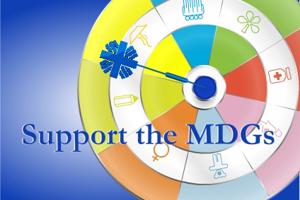
Halftime but not halfway: MDGS and HIV
The Millennium Development Goals form a plan agreed by world leaders to help millions of people out of poverty by 2015. Caritas is a supporter of Stand Up, a global mobilisation to end poverty and inequality and for the MDGs.
This year, we are asking people to Stand Up and Take Action on October 17-19, to ensure governments worldwide hear our demands to end poverty and inequality.
To add to the debate, Head of the Caritas Delegation at the UN in Geneva, Rev. Msgr. Robert J. Vitilllo, takes a look at MDGs and HIV.
Eradicate extreme poverty and hunger
The poor are not necessarily more likely to become infected with HIV, but the impact of HIV infection can be magnified by poverty. In India, the financial burden associated with HIV represents 82% of annual income for the poorest households, while the comparable burden for the wealthiest families is around 20%.
HIV also poses a threat to accomplishing another objective set out in MDG 1 – to reduce by one-half the situation of world hunger. In Rwanda, a death in a rural household is associated with an 18% decline in average household bean production.
Achieve Universal Primary Education
According to a survey done in 56 countries, orphans are 12% less likely to attend school than are non-orphans. If we do not make significant progress in achieving universal access to care, support, and treatment, for both adults and children living with or affected by HIV, we can expect additional increases in the AIDS orphan population. In Kenya, evidence shows the number of hours children are in school each week increases by 20% within six months of initiation of antiretroviral medications in their homes.
Promote Gender Equality and Empower Women
Women represent more than 60% of people living with HIV in sub-Saharan Africa. As the primary caregivers in Africa and other regions, women have seen their household and community burdens grow as a result of HIV, and this situation often compromises their health and their ability to generate income. In Botswana and Swaziland, women who lack sufficient food are 80% more likely to trade sexual “favours” for survival.
Reduce Child Mortality
Each year, some 300,000 children under 15 years of age die of HIV-related causes; many such deaths could have been prevented if they had access to safe, effective, and affordable child-friendly medications.
During the past decade, in 27 countries, there has been stagnation and even some reversal of progress made in reducing child mortality. The impact of HIV is thought to be responsible. Once adults living with HIV obtain access to antiretroviral medications, the children living in those same households experience sharp improvements in their nutritional status. A recent study in Uganda found an 81% reduction in child mortality among uninfected children of adults on antiretroviral medications.
Combat HIV/AIDS, malaria, and other diseases
For people living with HIV, access to antiretroviral medications could mean the difference between life and death and between chronic and increasingly more debilitating infections and more years of self-sufficiency and ability to care and provide for one’s children, elderly parents, and other dependents. Overall, antiretroviral treatment coverage rose by 42 per cent in 2007, reaching 3 million people in low- and middle-income countries, approximately 30 per cent of those in need.
Ensure Environmental Sustainability
Without access to clean water, people living with HIV (and thus with compromised immune systems) risk development of diarrheal diseases and other infections that could shorten their lives; HIV-infected children are particularly vulnerable to such problems. People taking anti-retroviral medications need greater amounts of potable water. At present, too little attention is accorded to the link between water, sanitation, and HIV.
Develop a Global Partnership for Development
The World Health Organization is promoting a plan “in cooperation with pharmaceutical companies, [to] provide access to affordable essential drugs in developing countries” and “in cooperation with the private sector, [to] “make available the benefits of new technologies – especially information and communications technologies”. Regrettably, progress with the formulation of such an action plan has advanced quite slowly.
Making it happen:
Funding for HIV-related activities in low- and middle-income countries reached $10 billion in 2007 — a tenfold increase in less than a decade. In such countries, per capita domestic spending on HIV more than doubled between 2005 and 2007.
Most regrettably, in the field of HIV service delivery, these newly-found global resources do not seem to flow, on an equitable basis, to faith-based organizations. A specific case in point is the Global Fund. As of April 2008, only 5.4% of the Global Fund has been granted to organizations related to churches or to other faith traditions. This stands in stark contrast to the 30% and 70% of the health infrastructure in Africa is currently owned by faith-based organizations.
This report is an abstract from “The Impact of HIV/AIDS on Development, with Special Focus on Africa” by Rev. Msgr. Robert J. Vitillo at Development Aid and Cooperation 2008 Conference sponsored by Caritas Slovakia, Bratislava, 09 October 2008
